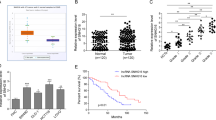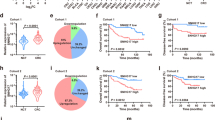Abstract
Colorectal cancer (CRC) is regarded as one of the top ten malignant cancers, which has caused millions of mortalities all over the world. Although advanced therapeutic methods have been employed to treat CRC, the prognosis of CRC patients remains unsatisfactory. Many researchers claimed long noncoding RNAs (lncRNAs) frequently participate in the development of cancers. Small nucleolar RNA host gene 14 (SNHG14) was proved to play roles in various cancers. Nevertheless, neither biological function nor regulatory mechanism of SNHG14 has been explored in CRC. This investigation is aimed at exploring the role of SNHG14 in CRC. The expression of genes including SNHG14, miR-32-5p, and ski-oncogene-like (SKIL) was measured by RT-qPCR assay. 5-Ethynyl-2′-deoxyuridine (EdU) assay was employed to measure cell proliferation. Cell migration and invasion were evaluated by transwell assay. Western blot assay was performed to test the protein expression. The binding capacity between miR-32-5p and SNHG14 (or SKIL) was explored by luciferase reporter and RNA immunoprecipitation (RIP) assays. SNHG14 expression is upregulated in CRC cells. Moreover, SNHG14 suppression inhibited the proliferation, metastasis, and epithelial-mesenchymal transition (EMT) process in CRC cells. miR-32-5p presented lower expression, which was negatively regulated by SNHG14. SKIL could combine with miR-32-5p. The mRNA and protein expression of SKIL was downregulated by SNHG14 knockdown or miR-32-5p overexpression. At last, the inhibitory effect of SNHG14 suppression on proliferation, metastasis, and EMT process was rescued by SKIL overexpression. SNHG14 regulates CRC progression via miR-32-5p/SKIL axis, providing a novel point in treatment of CRC patients.





Similar content being viewed by others
References
Ballester V, Rashtak S, Boardman L (2016) Clinical and molecular features of young-onset colorectal cancer. World J Gastroenterol 22:1736–1744
Bundela S, Sharma A, Bisen PS (2014) Potential therapeutic targets for oral cancer: ADM, TP53, EGFR, LYN, CTLA4, SKIL, CTGF, CD70. PLoS One 9:e102610
Cai C, Huo Q, Wang X, Chen B, Yang Q (2017) SNHG16 contributes to breast cancer cell migration by competitively binding miR-98 with E2F5. Biochem Biophys Res Commun 485:272–278
Chen Y, Yu X, Xu Y, Shen H (2017) Identification of dysregulated lncRNAs profiling and metastasis-associated lncRNAs in colorectal cancer by genome-wide analysis. Cancer Med 6:2321–2330
Dong H, Wang W, Chen R, Zhang Y, Zou K, Ye M, He X, Zhang F, Han J (2018a) Exosome-mediated transfer of lncRNASNHG14 promotes trastuzumab chemoresistance in breast cancer. Int J Oncol 53:1013–1026
Dong H, Wang W, Mo S, Liu Q, Chen X, Chen R, Zhang Y, Zou K, Ye M, He X, Zhang F, Han J, Hu J (2018b) Long non-coding RNA SNHG14 induces trastuzumab resistance of breast cancer via regulating PABPC1 expression through H3K27 acetylation. J Cell Mol Med 22:4935–4947
Iguchi T, Uchi R, Nambara S, Saito T, Komatsu H, Hirata H, Ueda M, Sakimura S, Takano Y, Kurashige J, Shinden Y, Eguchi H, Sugimachi K, Maehara Y, Mimori K (2015) A long noncoding RNA, lncRNA-ATB, is involved in the progression and prognosis of colorectal cancer. Anticancer Res 35:1385–1388
Ji N, Wang Y, Bao G, Yan J, Ji S (2019) LncRNA SNHG14 promotes the progression of cervical cancer by regulating miR-206/YWHAZ. Pathol Res Pract 215:668–675
Li Z, Hou P, Fan D, Dong M, Ma M, Li H, Yao R, Li Y, Wang G, Geng P, Mihretab A, Liu D, Zhang Y, Huang B, Lu J (2017) The degradation of EZH2 mediated by lncRNA ANCR attenuated the invasion and metastasis of breast cancer. Cell Death Differ 24:59–71
Liu G, Ye Z, Zhao X, Ji Z (2017) SP1-induced up-regulation of lncRNA SNHG14 as a ceRNA promotes migration and invasion of clear cell renal cell carcinoma by regulating N-WASP. Am J Cancer Res 7:2515–2525
Liu J, Li C, Xu J, Wu H (2018) A patient-oriented clinical decision support system for CRC risk assessment and preventative care. BMC Med Inform Decis Mak 18:118
Liu YJ, Zhou HG, Chen LH, Qu DC, Wang CJ, Xia ZY, Zheng JH (2019) MiR-32-5p regulates the proliferation and metastasis of cervical cancer cells by targeting HOXB8. Eur Rev Med Pharmacol Sci 23:87–95
Mao Z, Li H, Du B, Cui K, Xing Y, Zhao X, Zai S (2017) LncRNA DANCR promotes migration and invasion through suppression of lncRNA-LET in gastric cancer cells. Biosci Rep 37:BSR20171070
Mo Y, He L, Lai Z, Wan Z, Chen Q, Pan S, Li L, Li D, Huang J, Xue F, Che S (2018) LINC01287/miR-298/STAT3 feedback loop regulates growth and the epithelial-to-mesenchymal transition phenotype in hepatocellular carcinoma cells. J Exp Clin Cancer Res 37:149
Mohr AM, Mott JL (2015) Overview of microRNA biology. Semin Liver Dis 35:3–11
Qi X, Shao M, Sun H, Shen Y, Meng D, Huo W (2017) Long non-coding RNA SNHG14 promotes microglia activation by regulating miR-145-5p/PLA2G4A in cerebral infarction. Neuroscience 348:98–106
Shinozuka E, Miyashita M, Mizuguchi Y, Akagi I, Kikuchi K, Makino H, Matsutani T, Hagiwara N, Nomura T, Uchida E, Takizawa T (2013) SnoN/SKIL modulates proliferation through control of hsa-miR-720 transcription in esophageal cancer cells. Biochem Biophys Res Commun 430:101–106
Tutar Y (2014) miRNA and cancer; computational and experimental approaches. Curr Pharm Biotechnol 15:429
Wang J, Cao L, Wu J, Wang Q (2018a) Long non-coding RNA SNHG1 regulates NOB1 expression by sponging miR-326 and promotes tumorigenesis in osteosarcoma. Int J Oncol 52:77–88
Wang J, Lu Y, Ding H, Gu T, Gong C, Sun J, Zhang Z, Zhao Y, Ma C (2018b) The miR-875-5p inhibits SATB2 to promote the invasion of lung cancer cells. Gene 644:13–19
Wu Y, Hu L, Liang Y, Li J, Wang K, Chen X, Meng H, Guan X, Yang K, Bai Y (2017) Up-regulation of lncRNA CASC9 promotes esophageal squamous cell carcinoma growth by negatively regulating PDCD4 expression through EZH2. Mol Cancer 16:150
Xie SD, Qin C, Jin LD, Wang QC, Shen J, Zhou JC, Chen YX, Huang AH, Zhao WH, Wang LB (2019) Long noncoding RNA SNHG14 promotes breast cancer cell proliferation and invasion via sponging miR-193a-3p. Eur Rev Med Pharmacol Sci 23:2461–2468
Xu Q, Zhu Q, Zhou Z, Wang Y, Liu X, Yin G, Tong X, Tu K (2018) MicroRNA-876-5p inhibits epithelial-mesenchymal transition and metastasis of hepatocellular carcinoma by targeting BCL6 corepressor like 1. Biomed Pharmacother 103:645–652
Yu B, Shan G (2016) Functions of long noncoding RNAs in the nucleus. Nucleus 7:155–166
Zhang CL, Zhu KP, Ma XL (2017a) Antisense lncRNA FOXC2-AS1 promotes doxorubicin resistance in osteosarcoma by increasing the expression of FOXC2. Cancer Lett 396:66–75
Zhang L, Li X, Chao Y, He R, Liu J, Yuan Y, Zhao W, Han C, Song X (2018) KLF4, a miR-32-5p targeted gene, promotes cisplatin-induced apoptosis by upregulating BIK expression in prostate cancer. Cell Commun Sign 16:53
Zhang W, Yuan W, Song J, Wang S, Gu X (2017b) LncRna CPS1-IT1 suppresses cell proliferation, invasion and metastasis in colorectal cancer. Cell Physiol Biochem 44:567–580
Zhang Z, Wang Y, Zhang W, Li J, Liu W, Lu W (2019) Long non-coding RNA SNHG14 exerts oncogenic functions in non-small cell lung cancer through acting as an miR-340 sponge. Biosci Rep 39
Acknowledgments
We appreciate the support of Regional Science Fund Project of the National Natural Science Foundation of China (Nos. 81760814, 81860819), High-level Innovative Talent Training Plan of Guizhou (100 levels) (the Qian family matches the talented person [2016] No. 4032), TCM Tumor Inheritance and Scientific And Technological Innovation Talent Base of Guizhou Province (Guizhou people lead [2018] No. 3), Doctor Foundation of the First Affiliated Hospital of Guizhou University of Traditional Chinese Medicine (GYZYYFY-BS-2018[10]) and Research Project of Traditional Chinese Medicine and Ethnic Medicine Science and Technology of Guizhou Provincial Administration of Traditional Chinese Medicine (No. QZYY-2019-18).
Author information
Authors and Affiliations
Corresponding author
Ethics declarations
The present investigation was approved by the committee of the First Affiliated Hospital of Guizhou University of Traditional Chinese Medicine
Conflict of interest
The authors declare that there are no competing interests.
Additional information
Editor: Tetsuji Okamoto
Electronic supplementary material
Fig S1
(A-B) The expression of proteins related to TGF-β and Wnt/β-catenin signaling pathway was examined by western blot assay. (C) The expression of SNHG14 was tested by RT-qPCR. *P < 0.05, **P < 0.01. (PNG 297 kb)
Rights and permissions
About this article
Cite this article
Ye, T., Zhang, N., Wu, W. et al. SNHG14 promotes the tumorigenesis and metastasis of colorectal cancer through miR-32-5p/SKIL axis. In Vitro Cell.Dev.Biol.-Animal 55, 812–820 (2019). https://doi.org/10.1007/s11626-019-00398-5
Received:
Accepted:
Published:
Issue Date:
DOI: https://doi.org/10.1007/s11626-019-00398-5




